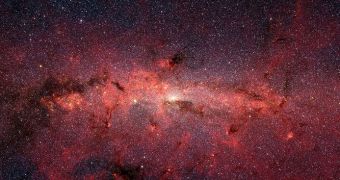Physicists in the United States believe that they may have discovered the most compelling proof that dark matter indeed exists, deep within the core of our own galaxy, the Milky Way.
The team believes that it is the first group to demonstrate that the elusive substance actually exists. Thus far, experts have only assumed that it does, based on the gravitational pull it exerts on normal matter.
Years ago, investigators seeking to understand how the Universe operates and organizes have proposed the existence of dark matter and dark energy to account for the way galaxies are distributed, and for the expansion of the Universe, respectively.
None of two have ever been observed directly, and not for lack of trying. Numerous experiments were set up in space and deep underground, as teams competed to be the first to announce the discovery of either dark matter or dark energy to the world.
In a new study, an expert at Fermilab and the University of Chicago provides what his team believes is the first direct evidence that destroyed dark matter exists deep within the core of the Milky Way.
The discovery is not impossible, other physicists comment, considering that there are more chances of the stuff colliding with cosmic rays at the galactic center, which would produce recognizable results.
Cosmologist and lead paper author Dan Hooper explains: “We’ve considered every astronomical source and nothing we know of, except dark matter, can account for the observations.”
“No other explanation comes anywhere close,” he adds. “This is the first study I know of that pulls together a few threads of evidence for dark matter together with one simple particle model,” adds Fermilab astrophysicist Craig Hogan, who did not work on the study.
He goes on to say that while the discovery still needs additional proof before it can be recognized, it does provide a unique starting point for conducting follow-up studies.
Physicists believe that dark matter is made up of weakly interacting massive particles (WIMP), which are considerably more energetic that a proton of normal matter.
Even if the new discovery turns out to have other explanations that the destruction of dark matter, investigators are convinced that they will find the stuff by 2020.
“This decade is the decade of dark matter. The problem is ripe to solve. We’ve gotten to this point where all of these detectors are looking in the right places,” says University of Chicago cosmologist Michael Turner.
Hooper agrees with his colleague, but adds that he has never “been this excited about being a cosmologist ever before,” Wired reports.

 14 DAY TRIAL //
14 DAY TRIAL //